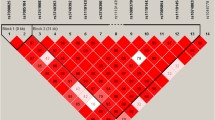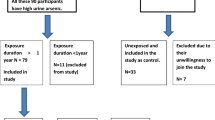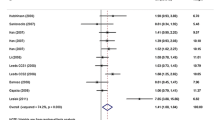Abstract
More than 2,000 arsenic-related skin lesions (as at 2002) in a few villages of China’s Southwest Guizhou Autonomous Prefecture represent a unique case of endemic arseniasis related with indoor combustion of high-arsenic coal. The skin lesion prevalence was significantly higher in ethnic Han villagers than in ethnic Hmong villagers. This study was focused on a possible involvement of XPD/ERCC2 G 23591 A and A 35931 C polymorphisms in risk modulation of skin lesions and in the body burden of As in this unique case of As exposure. G 23591 A and A 35931 C were genotyped by a PCR-based procedure. Total As contents in hair and urine samples as well as environmental samples of the homes of the two ethnic clans were analysed. A significant higher presentation of A/A 35931 (homozygous wild) genotype in both clans was found in skin lesion patients, compared with their asymptomatic fellow villagers (67.1 vs. 46.3%, OR 2.36, 95% CI 1.35–4.14, P = 0.002). Interestingly, the population frequencies of the A/A 35931 genotype did not show significant differences between ethnic Han villagers and their Hmong neighbours (47.1 vs. 45.5%). Very low frequencies of homozygous and heterozygous variant genotypes of G 23591 A were recorded in the residents in target village. G/A 23591 and A/A 23591 were detected only in 3.2% (8/244) and 0.8% (2/244) of the villagers, respectively. The polymorphic status at the locus of A 35931 C might modulate the risk for arsenic-related skin lesions in the investigated groups.
Similar content being viewed by others
References
Ahsan H, Chen Y, Wang Q, Slavkovich V, Graziano JH, Santella RM (2003) DNA repair gene XPD and susceptibility to arsenic-induced hyperkeratosis. Toxicol Lett 143:123–131
Banerjee M, Sarkar J, Das JK, Mukherjee A, Sarkar AK, Mondal L, Giri AK (2007) Polymorphism in the ERCC2 codon 751 is associated with arsenic-induced premalignant hyperkeratosis and significant chromosome aberrations. Carcinogenesis 28:672–676
Banerjee M, Sarma N, Biswas R, Roy J, Mukherjee A, Giri AK (2008) DNA repair deficiency leads to susceptibility to develop arsenic-induced premalignant skin lesions. Int J Cancer 123:283–287
Casson AG, Zheng ZY, Evans SC, Veugelers PJ, Porter GA, Guernsey DL (2005) Polymorphisms in DNA repair genes in the molecular pathogenesis of esophageal (Barrett) adenocarcinoma. Carcinogenesis 26:1536–1541
Chen CJ, Hsu LI, Wang CH, Shih WL, Hsu YH, Tseng MP et al (2005) Biomarkers of exposure, effect, and susceptibility of arsenic-induced health hazards in Taiwan. Toxicol Appl Pharmacol 206:198–206
Chen JG, Lin GF, Chen YG, Jia CG, Zhou YS, Meng H et al (2009) Arseniasis prevalence and mortality in a multiethnic, endemic township in Guizhou, China. Int Arch Occup Environ Health 82:499–508
Ding ZH, Zheng BS, Long JP, He BK, Finkelman RB, Chen CG et al (2001) Geological and geochemical characteristics of high arsenic coal from endemic arseniasis area in southwestern Guizhou Province, China. Appl Geochem 16:1353–1360
Dybdahl M, Vogel U, Frentz G, Wallin H, Nexø BA (1999) Polymorphisms in the DNA repair gene XPD: correlations with risk and age at onset of basal cell carcinoma. Cancer Epidemiol Biomarkers Prev 8:77–81
Ferreccio C, Gonzalez C, Milosavjlevic V, Marshall G, Sancha AM, Smith AH (2000) Lung cancer and arsenic concentrations in drinking water in Chile. Epidemiology 11:673–679
Hemminki K, Xu G, Angelini S, Snellman E, Jansen CT, Lambert B, Hou SM (2001) XPD exon 10 and 23 polymorphisms and DNA repair in human skin in situ. Carcinogenesis 22:1185–1188
Hopenhayn-Rich C, Biggs ML, Smith AH (1998) Lung and kidney cancer mortality associated with arsenic in drinking water in Cordoba, Argentina. Int J Epidemiol 27:561–567
Hou SM, Fält S, Angelini S, Yang K, Nyberg F, Lambert B, Hemminki K (2002) The XPD variant alleles are associated with increased aromatic DNA adduct level and lung cancer risk. Carcinogenesis 23:599–603
Huang C, Ke Q, Costa M, Shi X (2004) Molecular mechanisms of arsenic carcinogenesis. Mol Cell Biochem 255:57–66
International Agency for Research on Cancer (IARC) (1987) IARC monograph on the evaluation of carcinogenic risks to humans: overall evaluation of carcinogenicity: an update of IARC monographs 1 to 42 (Suppl 7), International Agency for Research on Cancer, Lyon, France
Jiao L, Hassan MM, Bondy ML, Abbruzzese JL, Evans DB, Li D (2007) The XPD Asp312Asn and Lys751Gln polymorphisms, corresponding haplotype, and pancreatic cancer risk. Cancer Lett 245:61–68
Jin Y, Liang C, He G, Cao J (2003) Study on distribution of endemic arsenism in China. Wei Sheng Yan Jiu (J Hyg Res) 32:519–540 (in Chinese)
Justenhoven C, Hamann U, Pesch B, Harth V, Rabstein S, Baisch C et al (2004) ERCC2 genotypes and a corresponding haplotype are linked with breast cancer risk in a German population. Cancer Epidemiol Biomarkers Prev 13:2059–2064
Li C, Hu Z, Liu Z, Wang LE, Strom SS, Gershenwald JE et al (2006) Polymorphisms in the DNA repair genes XPC, XPD, and XPG and risk of cutaneous melanoma: a case–control analysis. Cancer Epidemiol Biomarkers Prev 15:2526–2532
Lin GF, Chen JG, Zhou YS, Shen JH (2003) Family aggregation of chronic arsenic poisoning associated with indoor burning of high arsenic coal. Toxicology 191:19 (abstract)
Lin GF, Du H, Chen JG, Lu HC, Guo WC, Meng H et al (2006) Arsenic-related skin lesions and glutathione S-transferase P1 A1578G (Ile105Val) polymorphism in two ethnic clans exposed to indoor combustion of high arsenic coal in one village. Pharmacogenet Genomics 16:863–871
Lin GF, Du H, Chen JG, Lu HC, Kai JX, Zhou YS et al (2007) Glutathione S-transferases M1 and T1 polymorphisms and arsenic content in hair and urine in two ethnic clans exposed to indoor combustion of high arsenic coal in Southwest Guizhou, China. Arch Toxicol 81:545–551
Liu J, Zheng BS, Aposian HV, Zhou Y, Chen ML, Zhang A, Waalkes MP (2002) Chronic arsenic poisoning from burning high-arsenic containing coal in Guizhou, China. Environ Health Perspect 110:119–122
Lovatt T, Alldersea J, Lear JT, Hoban PR, Ramachandran S, Fryer AA et al (2005) Polymorphism in the nuclear excision repair gene ERCC2/XPD: association between an exon 6-exon 10 haplotype and susceptibility to cutaneous basal cell carcinoma. Hum Mutat 25:353–359
Lunn RM, Helzlsouer KJ, Parshad R, Umbach DM, Harris EL, Sanford KK, Bell DA (2000) XPD polymorphisms: effects on DNA repair proficiency. Carcinogenesis 21:551–555
Povey JE, Darakhshan F, Robertson K, Bisset Y, Mekky M, Rees J et al (2007) DNA repair gene polymorphisms and genetic predisposition to cutaneous melanoma. Carcinogenesis 28:1087–1093
Seker H, Butkiewicz D, Bowman ED, Rusin M, Hedayati M, Grossman L, Harris CC (2001) Functional significance of XPD polymorphic variants: attenuated apoptosis in human lymphoblastoid cells with the XPD 312 Asp/Asp genotype. Cancer Res 61:7430–7434
Spitz MR, Wu XF, Wang YF, Wang LE, Shete S, Amos CI et al (2001) Modulation of nucleotide excision repair capacity by XPD polymorphisms in lung cancer patients. Cancer Res 61:1354–1357
Sturgis EM, Zheng R, Li L, Castillo EJ, Eicher SA, Chen MH (2000) XPD/ERCC2 polymorphisms and risk of head and neck cancer: a case–control analysis. Carcinogenesis 21:2219–2223
Terry MB, Gammon MD, Zhang FF, Eng SM, Sagiv SK, Paykin AB (2004) Polymorphism in the DNA repair gene XPD, polycyclic aromatic hydrocarbon-DNA adducts, cigarette smoking, and breast cancer risk. Cancer Epidemiol Biomarkers Prev 13:2053–2058
Tomescu D, Kavanagh G, Ha T, Campbell T, Melton DW (2001) Nucleotide excision repair gene XPD polymorphisms and genetic predisposition to melanoma. Carcinogenesis 22:403–408
Tondel M, Rahman M, Magnuson A, Chowdhury IA, Faruquee MH, Ahmad SA (1999) The relationship of arsenic levels in drinking water and the prevalence rate of skin lesions in Bangladesh. Environ Health Perspect 107:727–729
Vahter M (2000) Genetic polymorphism in the biotransformation of inorganic arsenic and its role in toxicity. Toxicol Lett 112–113:209–217
Vogel U, Hedayati M, Dybdahl M, Grossman L, Nexø BA (2001) Polymorphisms of the DNA repair gene XPD: correlations with risk of basal cell carcinoma revisited. Carcinogenesis 22:899–904
Yin J, Vogel U, Ma Y, Qi R, Sun Z, Wang H (2007) A haplotype encompassing the variant allele of DNA repair gene polymorphism ERCC2/XPD Lys751Gln but not the variant allele of Asp312Asn is associated with risk of lung cancer in a northeastern Chinese population. Cancer Genet Cytogenet 175:47–51
Yu HP, Wang XL, Sun X, Su YH, Wang YJ, Lu B et al (2004) Polymorphisms in the DNA repair gene XPD and susceptibility to esophageal squamous cell carcinoma. Cancer Genet Cytogenet 154:10–15
Zheng BS, Wang BB, Ding ZH, Zhou DX, Zhou YS, Chen Z, Chen CC, Finkelman RB (2005) Endemic arsenosis caused by indoor combustion of high-As coal in Guizhou Province, PR China. Environ Geochem Health 27(5–6):521–528
Zhou DX, Liu DN, Zhu SL, Li BL, Jin DX, Zhou YS et al (1993) Investigation of chronic arsenic poisoning caused by high arsenic coal pollution. Chin J Prev Med 27:147–150 (in Chinese)
Zhou DX, Zhou YS, Zhou C, Jin DX, Peng JH, Luo ML et al (1994) Correlation of total arsenic intake and incidence of arsenic poisoning in coal type endemic area. Chin J Endem Dis 13:215–218 (in Chinese)
Author information
Authors and Affiliations
Corresponding author
Rights and permissions
About this article
Cite this article
Lin, Gf., Du, H., Chen, Jg. et al. Association of XPD/ERCC2 G 23591 A and A 35931 C polymorphisms with skin lesion prevalence in a multiethnic, arseniasis-hyperendemic village exposed to indoor combustion of high arsenic coal. Arch Toxicol 84, 17–24 (2010). https://doi.org/10.1007/s00204-009-0474-3
Received:
Accepted:
Published:
Issue Date:
DOI: https://doi.org/10.1007/s00204-009-0474-3




